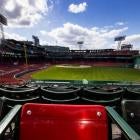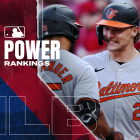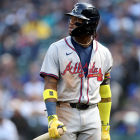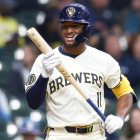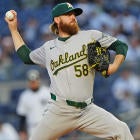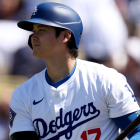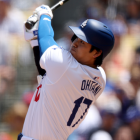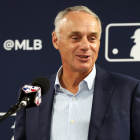The word of the moment is "testing." No matter how many hours, weeks, and what feels like months and years that I spend contemplating how and when Major League Baseball may return, I can't escape the reality that rapid and plentiful testing for COVID-19 is the critical prerequisite to any possible scenario.
Testing is necessary and a prerequisite, but not a plan. Here, I draw on my nearly 20 years as a top-level Major League Baseball executive to devise a plan that would allow baseball to resume. This plan comes after consulting with executives around the league and studying best practices employed by the Korean Baseball Organization and other leagues that either have started back up or announced their plans to do so around the globe.
Unfortunately, our new reality is that there will be no fans at MLB games this season. The safety concerns for fans are immense and the key factor, but another under-discussed element is that opening ballparks to the public costs a lot of money, with no guarantee that people will fill the parks. Pro sports leagues around the world will need to figure out how to handle those needs safely, and those changes must take place before the 2021 season.
In order to have a 2020 fan-less season, there still are many steps that need to be taken. This article outlines the process through which a return to play could be feasible. Everything that follows assumes these measures are in place:
- There are enough available tests in the United States and Canada that each person included in this plan will be tested every other day. That also means non-baseball support employees, including, but not limited to hotel staff and transportation personnel.
- The border between the United States and Canada is re-opened.
- Social distancing guidelines remain in effect.
- Masks must be made available to each team member and other personnel needed as part of this pan. Masks must be worn at all times except by players on the field. This includes at team hotels.
- Each team's road hotel must agree to have the entire traveling party on exclusive floors.
- All members of the traveling party agree to contact tracing measures. I understand the privacy issues involved with this, but desperate times call for desperate, and draconian measures.
These are basic necessities. Everything that comes after they are in place, that is up for debate. This article will help set those measures up, and I also discussed the subject on the latest episode of my daily CBS Sports podcast, "Nothing Personal":
The goal is to end the season with a World Series champion. There will be a modified spring training, an 81-game regular season and a postseason. Roster limits will be altered to ensure teams have the personnel to make it through a season. Travel will be kept to a minimum throughout. From here, let me break down how each phase of the season will be handled, starting with some necessary rules changes.
Rule changes
Starting in spring training and continuing into the regular season, the following rule changes would be both necessary and beneficial in this truncated season:
- All games will include a designated hitter.
- There will be no mound visits during the game, and pitching changes would be done from the dugout.
- Extra-inning games will be played as follows:
• The 10th inning will have a runner on 2nd base with no outs for each team.
• The 11th inning will have a runner on 2nd base and 3rd base with no outs for each team.
• The 12th inning will have the bases loaded with no outs for each team.
• If the game is still tied after 12 innings, then the result will be a tie. Except for postseason games, when each inning after the 11th inning will start with the bases loaded and no outs until there is a winner. - There will be no spitting of sunflower seeds or chewing tobacco permitted. There will be no sharing of beverages in the dugouts. Each player will have his own cooler and gum/energy bar supply.
- Once a player is removed from a game, he will be forced to leave the dugout, shower in the clubhouse and leave the facility. Each road team must have enough buses available so that shuttling of players in small groups to and from the ballpark may be easily facilitated. No taxis or ride shares will be allowed to transport players to and from the ballpark.
- There will be absolutely no visitors, media members or any other people allowed in the clubhouse.
- There will be no instant replay. The video room will be shut during the game, and the video coordinator will leave the facility before the game begins.
- There will be no first- and third-base coaches on the field. This helps minimize the number of people at each game. Signs will be given by coaches from the dugout. For those concerned about waving runners home from third base or telling a batter to go to second base on a batted ball, the absence of fans will allow those signals to be given orally from the dugout coaches. The main reason for the "hand" signs by the base coaches is that it is very difficult to hear during a regular fan-filled game. There is no competitive disadvantage to everyone hearing that a batter will attempt to advance rather than looking to the base coaches for the universal stop/advance sign.
- The following staff members will be permitted in the ballpark on game days: Manager, hitting coach, pitching coach, bench coach, (2) trainers, (1) strength coach, (4) clubhouse attendants, (1) traveling secretary, (2) owners, (1) president, (1) president of baseball operations, (1) general manager, (1) assistant GM, (1) public relations staff member and (1) doctor.
- Players may invite up to four people to each game, however, all guests must agree to be tested for COVID-19 and agree to contact tracing. They also will be expected to maintain safe social distance in the stands and elsewhere.
- All personnel, including players, will be temperature checked before gaining entrance to the ballpark. Any person with a temperature above the limit as defined by local state and federal guidelines will be administered a test, denied entry and sent home regardless of the test's outcome.
- There will be no broadcasters in the ballpark, but (1) reporter will have access to certain areas. The broadcasters will be able to broadcast the games on both TV and radio remotely.
- Only one player and the manager will meet the pool media member after each game, maintaining safe distance. Teams will make the manager and a player available for a pre- and postgame zoom with other media members, local and national.
- Players will also have to agree to contact tracing and every other day testing. If there is a positive test, the player will be quarantined for 14 days and those on that player's contact trace report will be tested every day but able to participate in full activities until they either show symptoms or test positive.
- The clubhouse will never be occupied by a full team. There will be staggered reporting times, depending on that particular game's lineup.
- The training room tables will be covered in a sanitary way, with only two players at a time allowed in the training room.
- The clubhouse weight room facilities will open in shifts, with full cleaning in between each use.
- The food room in the clubhouse will also be open in shifts, and only open pregame, with one player per table.
- Clubhouse lockers will be assigned, so that there is maximum spacing between players. All available clubhouses in a ballpark will be used. Most, if not all, ballparks have at least one auxiliary clubhouse.
- Clubhouse bathrooms/showers will also be done in shifts. For example, half the team will shower immediately after the game while the other half eats, and then they switch.
- The clubhouse spread usually is served buffet style. This will change. There will be no buffet. Pregame, each team will provide all food in individually wrapped packages. After the game, each player will take his individually wrapped meal on his way out of the clubhouse.
- Pregame batting practice and infield work will also be done with proper social distancing, meaning one person per defensive position. There will be no shagging balls during batting practice and pitchers will not take batting practice at all, with the exception of pre-certified two-way players.
- Within each stadium, there will be a maximum of four live cameras located behind home plate, in center field, behind first base and behind third base, with four camera operators, who would also need to be tested every other day and submit to contact tracing. Each team's broadcasts would share the same feed. Each stadium would also have one P.A. announcer. These broadcast personnel would not come in contact with players or baseball personnel.
'Spring' training
MLB was midway through spring training when the pandemic hit America. However, with everyone split up and, in most cases, removed from ideal facilities, it would be a mistake to start the season right away with no warm-up.
Spring training, part deux, would commence on July 6 with pitchers and catchers, then position players reporting on July 16. The sessions would be held in each team's home stadium. Intrasquad exhibitions would be the primary focus, with games between two teams allowed when feasible, such as White Sox vs. Cubs. Travel for those games would be via bus, and the limit would be a three-hour ride.
In order to accommodate intrasquad exhibitions, spring training rosters will have a maximum of 45 players, to avoid the masses of non-rostered invites that come through without contracts. Major-league rosters would be expanded to 45 players as well, up from the previous number of 40. The purpose of this expansion is to ensure that each team has enough serviceable pitchers to be used during the season and for the expanded rosters to be used in the regular season.
"Spring" training would only slightly resemble what we are used to seeing. Many hours are spent during the offseason by front offices and the coaching staff dealing with the logistics of spring training workouts. The old way of thinking is gone, and new norms must be developed. Instead of having six fields available, each team would have only one. This works because the players would work out in shifts throughout the day. Each shift change would include fully sanitizing the clubhouse. Minor-league coaches and trainers would assist with spring training by working shifts each day.
Regular season
My plan is to have Opening Day on Aug. 1. There will be an 81-game regular season lasting through Halloween, followed by November playoffs. Cutting the regular season in half obviously has some major financial implications, and the question of how to share the economic burden is a worthwhile topic on its own merit. I went into much of that debate on a recent edition of "Nothing Personal":
The regular season will have a balanced schedule within the three proposed divisions. A balanced schedule means that each team will play nine games against each division opponent. For those with quarantined, atrophied math skills, and whose phone is not charged, that is nine (9) games each against nine (9) teams for a total of 81 games.
As a reminder, the divisions would be the following, which mostly merge AL and NL divisions:
- East: Baltimore, Boston, Miami, N.Y. Mets, N.Y. Yankees, Philadelphia, Pittsburgh, Toronto, Tampa Bay, Washington
- Central: Atlanta, Chi. Cubs, Chi. White Sox, Cincinnati, Cleveland, Detroit, Kansas City, Milwaukee, Minnesota, St. Louis
- West: Arizona, Colorado, Houston, L.A. Dodgers, L.A. Angels, Oakland, San Diego, San Francisco, Seattle, Texas
Roster management would be tricky, especially if minor leagues can't return to full capacity and with the desire to minimize any personnel changes to prevent contamination. Teams would be allowed 34 players for their regular rosters and 45 players for their expanded rosters, with five new players receiving designations as typically would exist during a "normal" September.
That brings us to 17 position players and 17 pitchers on each traditional roster, with 28 active for any given game and six on a "taxi squad" available as needed. These decisions would need to be made in advance of showing up to the ballpark, and managers would need to submit starting lineups electronically rather than taking the transmission risks of lineup cards and handshakes.
The structure of the regular season would look quite different. Teams would play one four-game series and one five-game series against each opponent. Travel would be minimalized: Each team would have one 17-or-18-game, four-city road trip; one 15-game, three-opponent road trip; and one 8-game, two-opponent road trip. Each team also would have homestands of those lengths.
Postseason
The 2020 playoffs will be expanded to include 13 teams, up from 10. The reason for expanded playoffs is twofold. First, there would be extra national broadcast revenue to help offset the losses from the half-season, and second, a shorter season leads to less probable outcomes. Generally speaking, during the course of 162 games, better teams prevail, but 81 games is a small sample size.
The idea of holding the playoffs at a neutral site has been widely discussed and speculated. In my opinion, this would be a last resort. While people may think that home-field advantage is obviated by the absence of fans and the sounds of silence, there are other compelling reasons to play at home. Giving teams an incentive to make the regular season record count leads to increased competition and importance of each game. Playing at a neutral site would give the No. 4 seed and the 13th seed equal import. In addition, there does exist a home-field advantage in the form of length of infield and outfield grass and knowing how the ballpark plays better than your opponent. Also, don't underestimate the importance to a player who can sleep in his own bed the night before a game.
The three division winners will be given top seeds, while the other 10 teams will be seeded according to record. Division winners then will get a first-round bye:
- Round 1: Best of three, with every game played at the home stadium of the higher seed to reduce unnecessary travel.
- Round 2: Best of five, again with every game played at the home stadium of the higher seed.
- Round 3 (semifinals): Previously known as the League Championship Series round, this round will be structured differently. It will retain the classic best-of-seven format, but one team will open the series with three games at home, then the other will close with four games at home. Before the postseason, each team will decide which they prefer, and the higher-seeded team will get preference. This again helps mitigate travel.
- Round 4 (World Series): Same as the semifinals, with one team hosting the first three games, and the other hosting the next four.
Remember, the entire plan assumes that there is available rapid testing, where every player, staff and support member can and will be tested every other day. Every person would have to agree to submit to contact tracing, in case of a positive test or the onset of COVID-19 symptoms. Players would have to agree to a reduction in their prorated salaries, and owners would have to agree to new revenue-sharing rules.
If this happens, starting the season on Aug. 1 is not beyond the realm of possibility. An 81-game season, plus expanded playoffs, would result in a true champion for this unprecedented 2020 baseball season. And isn't that the object of the game?













